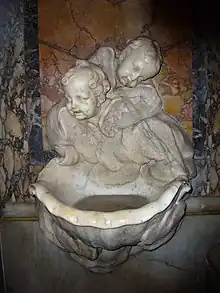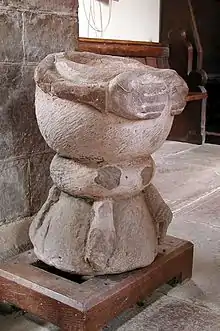Holy water font
A holy water font or stoup is a vessel containing holy water which is generally placed near the entrance of a church. It is often placed at the base of a crucifix or religious representation. It is used in the Catholic Church, Anglican Churches, and some Lutheran churches to make the sign of the cross using the holy water upon entrance of the church.[1] Holy water is blessed by a priest or a deacon, and many Christians believe it to be a reminder of the baptismal promises.[2]

Holy water font in Rome, Italy

Carved stoup at the entrance of the Church of St Mary and St David, Kilpeck, England

An Indian-style carved stoup at the Immaculate Conception Cathedral, Pondicherry, India
See also
- Baptismal font
- Nipson anomemata me monan opsin
- Home stoup, for usage and blessing at home
References
- Bertacchini, E. (1 January 2014). A New Perspective on the Production and Evolution of Cultures. Content Publishers. p. 183. ISBN 9781490272306.
A holy water font is a vessel containing holy water generally placed near the entrance of a church. It is used in Roman Catholic and Lutheran churches, as well as some Anglican churches to make the sign of the cross using the holy water upon entrance and exit.
- Gould, Meredith (1 September 2009). Why is There a Menorah on the Altar?: Jewish Roots of Christian Worship. Church Publishing, Inc. p. 71. ISBN 9781596272194.
Many Roman Catholic, Lutheran, and Anglican/Episcopal churches customarily sprinkle the assembly with water each Sunday during Easter. In liturgical churches, funeral services are begun by sprinkling water over the coffin. Getting sprinkled with holy water during liturgy is supposed to remind you of baptism.
External links
- "Holy Water Fonts" Catholic Encyclopedia article
- Using Holy Water in Daily Devotions by The Rev. Brandon L. Filbert (The Protestant Episcopal Church)
Wikimedia Commons has media related to Stoups.
This article is issued from Wikipedia. The text is licensed under Creative Commons - Attribution - Sharealike. Additional terms may apply for the media files.